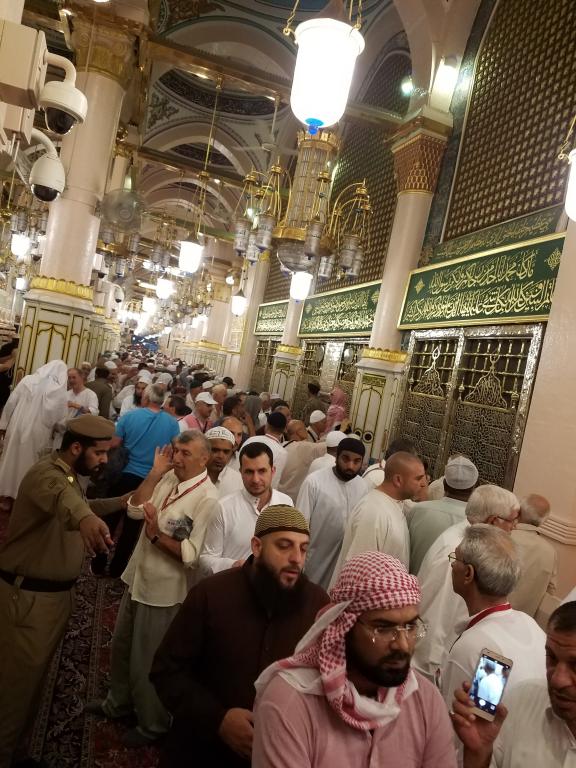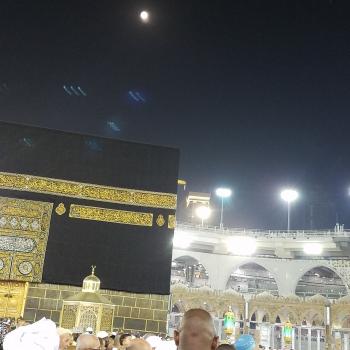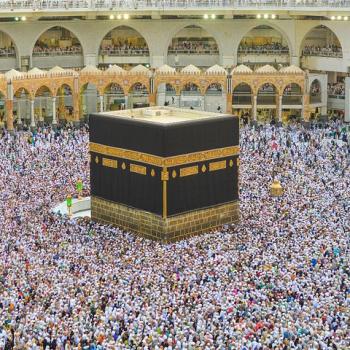
Visiting Prophet Muhammad’s mosque in medina and other holy sites was memorable but the Hajj had not even started. The rituals of Hajj pilgrimage start when you begin to approach Mecca. There are several sets of rituals that are required to complete Hajj. The first is to go to a place called Miqat to put your Ihram on. (The unstitched two pieces of white cloth), to make the intention and to recite talbiya. This was the first time when it started to really sink in that we are on the Hajj pilgrimage. I am including a video of the talbiya to give you the flavor of how it felt, though no vide will ever capture how we really felt.were
Now you are in a state of Ihram. Thus Ihram refers to the unstitched pieces of cloth as well as the state you are in till you complete your Umrah (minor pilgrimage) or Hajj. Not to confuse you but Umrah is also part of the Hajj.
We also offered two rak’at salat as is customary when you put the Ihram on.Once you are in the state of Ihram, you are in a purified state, which means certain things are forbidden. Cursing, fighting, getting angry, any lustful thoughts, sexual or even romantic encounters with your spouse, killing even an insect, wearing perfumes and scents or make-up are all forbidden. It is of note that during Hajj and Umrah(and at other times in Kaa’ba), men and women offer their prayers together, often side by side. The same goes with the tawaf ( circumambulation around Ka’aba seven times)- men and women do it together. In fact throughout the Hajj, me and my wife and my sister-in-law stayed together, holding each other’s hand (mainly to ensure the large crowds don’t get us separated).
Putting the Ihram (the cloth) put us in a different zone, mentally. It is when it struck home for the first time that we were on our Hajj pilgrimage. The stay in medina started to feel more like a (still sacred) vacation. The video below will give you a glimpse as to why you kinda get into a totally different state of mind- a higher state of spirituality, purification and simplicity.
Ihram was symbolic of the simplicity and unity that Hajj conveys so powerfully, putting the same simple piece of cloth on, regardless of our socioeconomic or educational status, our ethnicity, language, national origin, color of the skin etc. The billionaires stood shoulder to shoulder with the poor, PhDs and illiterates were viewed as the no different. Arriving from large, powerful countries meant nothing. Whether you were staying in a five star hotel seemed meaningless and completely irrelevant, as they were seen the same as those who barely had a roof over their head. We stood in front of our Creator as one and the same.
We were finally equal. Really!
The chanting, called talbiya, brings chills to me even to this day. You repeat the following multiple times when you first put the Ihram on, and when you begin to approach Ka’aba. This is the Arabic and its transliteration.
لَبَّيْكَ اللَّهُمَّ لَبَّيْكَ، لَبَّيْكَ لاَ شَرِيْكَ لَكَ لَبَّيْكَ، إِنَّ الْحَمْدَ وَالنِّعْمَةَ لَكَ وَالْمُلْكَ لاَشَرِيْكَ لَكَ
Labbayka Allāhumma Labbayk. Labbayk Lā Sharīka Laka Labbayk. Inna l-Ḥamda, Wa n-Niʻmata, Laka wal Mulk, Lā Sharīka Lak.
Translation: “Here I am at Your service O Lord, here I am. Here I am at your service and You have no partners. Yours alone is All Praise and All Bounty, and Yours alone is The Sovereignty. You have no partners.”
Labbayk is repeated several times, meaning ‘Here I am’.
(The Shia Muslim version of the talbiya is exactly the same as the Sunni Muslim one but ends with an extra “Labbayk.”)
Here is a video I took of a group ahead of us who completed their Ihram before us. You heard these chants numerous times throughout the journey from that time on till we reached Ka’aba in mecca.
Next post: In Mecca, to perform the Umrah, which in itself consists of several components including tawaf or circumambulation around Ka’aba.











